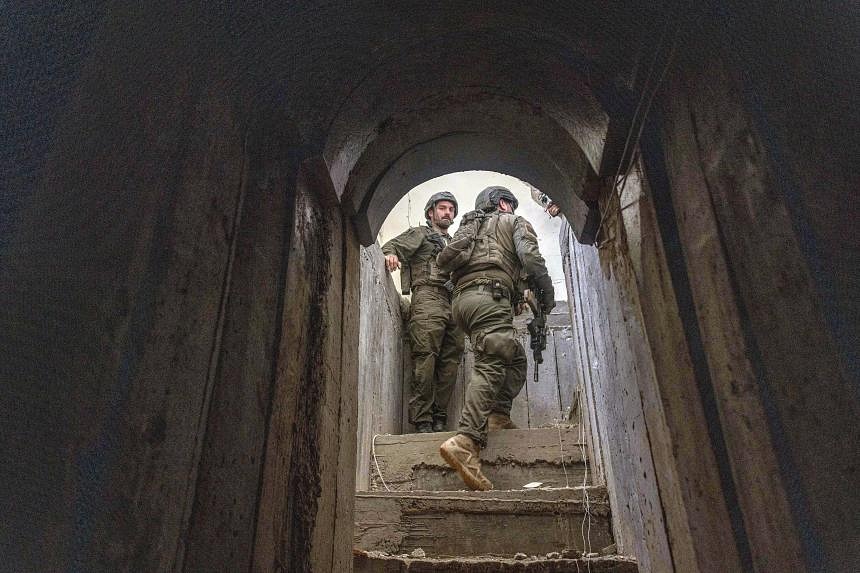TEL AVIV – One tunnel in the Gaza Strip was wide enough for a top Hamas official to drive a car through. Another tunnel stretched nearly three football fields long and was hidden beneath a hospital. Under the house of a senior Hamas commander, the Israeli military found a spiral staircase leading to a tunnel approximately seven storeys deep.
These details and new information about the tunnels, some made public by the Israeli military and documented by video and photographs, underscore why the tunnels were considered a major threat to the Israeli military in Gaza, even before the war started.
But Israeli officials and soldiers who have since been inside the tunnels – as well as current and former United States officials with experience in the region – say the scope, depth and quality of the tunnels built by Hamas have astonished them.
Even some of the machinery that Hamas used to build the tunnels, observed in captured videos, has surprised the Israeli military.
The Israeli military now believes there are far more tunnels under Gaza.
In December, the network was assessed to be an estimated 402km long. Senior Israeli defence officials, who spoke on condition of anonymity to discuss intelligence matters, are currently estimating that the network is between 563km and 724km – extraordinary figures for a territory that at its longest point is only 40km. Two of the officials also assessed there are close to 5,700 separate shafts leading down to the tunnels.
The numbers could not be independently verified, and there are varying estimates by Israeli officials for the increased scope of the tunnel network, based on different intelligence.
But the immense efforts of Hamas to militarise the enclave are not in dispute, nor are the intelligence failures of the Israeli military in underestimating the extent and importance of the network to Hamas’ survival.
In a meeting in January 2023, a top Israeli military official said the tunnels would not even be a factor in any future war with Hamas because of Israel’s military strength, according to a transcript of the discussion reviewed by The New York Times.
“Hamas has used the time and resources over the last 15 years to turn Gaza into a fortress,” said Mr Aaron Greenstone, a former CIA officer who has worked extensively in the Middle East.
For the Israeli military, the tunnels are a subterranean nightmare and the core of Hamas’ ability to survive. Every strategic goal of Israel in Gaza is now linked to wiping out the tunnels.
Dr Daphne Richemond-Barak, a tunnel warfare expert at Reichman University in Israel, said: “If you want to destroy the leadership and arsenal of Hamas, you have to destroy the tunnels. It’s become connected to every part of the military missions.”
Hamas has invested heavily in the tunnels since it does not have the resources nor numbers to fight the Israeli military in a conventional war. The group uses the tunnels as military bases and arsenals, and relies on them to move its forces undetected and protect its top commanders.
One 2022 document showed that Hamas budgeted US$1 million (S$1.34 million) for the tunnel doors, underground workshops and other expenses in Khan Younis.
Israeli intelligence officials recently assessed that there were about 160km of tunnels just under Khan Younis, southern Gaza’s largest city, where Israeli forces are now engaged in heavy fighting. Mr Yehia Sinwar, the military leader of Hamas in Gaza, had a home in Khan Younis.

In addition, a 2015 report indicated that Hamas had spent more than US$3 million on tunnels throughout Gaza, including many built under civilian infrastructure and sensitive locations such as schools and hospitals, the Israeli military said.
The military said it had found two types of tunnels: ones used by commanders and others used by operatives. The commander tunnels are deeper and more comfortable, allowing for longer stays and the use of ceramic tiles. The other tunnels are more spartan and often shallower.
An Israeli official said the military might have spent a year locating a single tunnel, but now, the ground campaign has provided a trove of information about Gaza’s underground network.
The Israeli military has examined computers used by Hamas operatives in charge of tunnel construction to find the underground passageways, a senior Israeli official said.
Some documents captured in the war are also proving vital. The Israeli military has found lists of families that “hosted” the tunnel entrances in their private homes.
In one case, Israeli soldiers located a map of tunnels in Beit Hanoun, a city in northern Gaza, and used it to find and destroy tunnels.
Even with this battlefield intelligence, the fighting in Gaza around the tunnels has been gruelling. The Israeli military reports that nearly 190 soldiers have been killed and about 240 seriously wounded since the ground campaign started. But the military has not disclosed the number of dead and wounded in connection with the tunnel warfare.
One soldier, speaking on the condition of anonymity for safety reasons, said he oversaw the destruction of about 50 tunnels in Beit Hanoun.
All of them were booby-trapped, he said. The soldier, an officer in the combat engineer unit, said his unit found bombs hidden in walls and a massive explosive device that was hard-wired to be remotely activated.
The soldier, who was a reservist and has since been discharged, said the device had been made in a factory and had a serial number on it. If it had gone off, the bomb would have killed anybody in the tunnel and directly outside it, he said. NYTIMES

